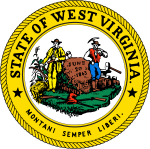
The 1956 United States presidential election was the 43rd quadrennial presidential election. It was held on Tuesday, November 6, 1956. President Dwight D. Eisenhower successfully ran for reelection against Adlai Stevenson II, the former Illinois governor whom he had defeated four years earlier. This election saw the sixth rematch in American presidential history, the last until 2024, and the second where the winner was the same both times. This was the last election before the term limits established by the 22nd Amendment came into effect, Eisenhower being the first President elected twice to the office following the Amendment's ratification.

The Solid South or the Southern bloc was the electoral voting bloc of the states of the Southern United States for issues that were regarded as particularly important to the interests of Democrats in those states. The Southern bloc existed between the end of the Reconstruction era in 1877 and the passage of the Civil Rights Act of 1964. During this period, the Democratic Party overwhelmingly controlled southern state legislatures, and most local, state and federal officeholders in the South were Democrats. During the late 1800s and early 1900s, Southern Democrats disenfranchised blacks in all Southern states, along with a few non-Southern states doing the same as well. This resulted essentially in a one-party system, in which a candidate's victory in Democratic primary elections was tantamount to election to the office itself. White primaries were another means that the Democrats used to consolidate their political power, excluding blacks from voting in primaries.

The 2000 United States House of Representatives elections were held on November 7, 2000, to elect U.S. Representatives to serve in the 107th United States Congress. They coincided with the election of George W. Bush as President of the United States. The Republican Party won 221 seats, while the Democratic Party won 212 and independents won two.
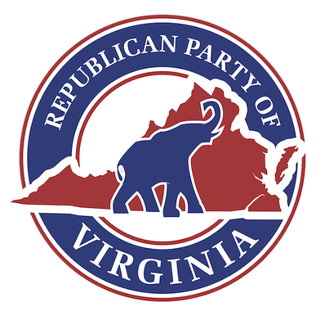
The Republican Party of Virginia (RPV) is the Virginia chapter of the Republican Party. It is based at the Richard D. Obenshain Center in Richmond.
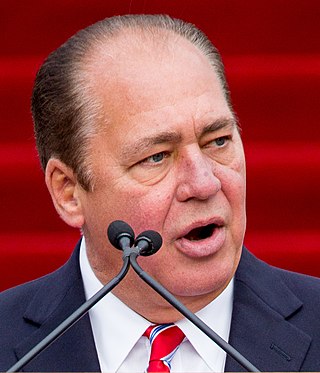
Earl Ray Tomblin is an American politician who served as the 35th governor of West Virginia from 2011 to 2017. A member of the Democratic Party, he previously served in the West Virginia Senate from 1980 to 2011 and as president of the West Virginia Senate from 1995 to 2011. Tomblin became acting governor in November 2010 following Joe Manchin's election to the U.S. Senate. He won a special election in October 2011 to fill the unexpired term ending on January 14, 2013, and was elected to a full term as governor in November 2012.
Howard W. Carson was an American Democratic politician. Carson was a member of the West Virginia Senate for the 11th district from 1956 to 1968. From 1961 to 1968, he served as President of the West Virginia Senate.

The 2004 West Virginia gubernatorial election took place on November 2, 2004 for the post of Governor of West Virginia. Democratic Secretary of State of West Virginia Joe Manchin defeated Republican Monty Warner. Manchin won all but 3 counties. Despite Democratic presidential nominee John Kerry losing the state to George W. Bush by double digits in the concurrent presidential election, Manchin won by nearly 30 points.
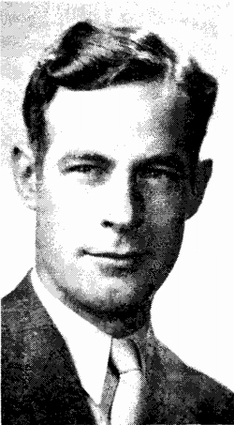
John Rinehart Blue was an American military officer, educator, businessperson, and politician in the U.S. state of West Virginia. Blue was a Democratic member of the West Virginia House of Delegates representing Hampshire County, from 1953 until 1959.

The 2012 United States presidential election in West Virginia took place on November 6, 2012, as part of the 2012 United States presidential election in which all 50 states plus the District of Columbia participated. West Virginia voters chose five electors to represent them in the Electoral College via a popular vote pitting incumbent Democratic President Barack Obama and his running mate, Vice President Joe Biden, against Republican challenger and former Massachusetts Governor Mitt Romney and his running mate, Congressman Paul Ryan.
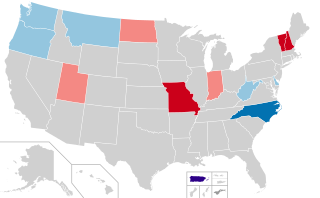
United States gubernatorial elections were held on November 8, 2016, in 12 states and two territories. The last regular gubernatorial elections for nine of the 12 states took place in 2012. The last gubernatorial elections for New Hampshire, Oregon, and Vermont took place in 2014, as Oregon held a special election due to the resignation of Governor John Kitzhaber, while the governors of New Hampshire and Vermont both serve two-year terms. The 2016 gubernatorial elections took place concurrently with several other federal, state, and local elections, including the presidential election, Senate, and House elections.

John "JB" McCuskey is an American politician who has served as West Virginia State Auditor since January 16, 2017. A Republican, he was a member of the West Virginia House of Delegates representing District 35 from 2013 to 2017. On February 28, 2023, he announced he would run for governor of West Virginia to attempt to succeed term limited governor Jim Justice. However, in July 2023 he announced that he would run for attorney general instead.

United States gubernatorial elections were held on November 7, 2017, in two states: Virginia and New Jersey. These elections formed part of the 2017 United States elections. The last regular gubernatorial elections for these two states were in 2013. Both incumbents were term-limited, so both seats were open. Democrats held the governorship in Virginia and picked up the governorship of New Jersey.

Mitchell Carmichael is an American politician. He is a former Republican member of the West Virginia Senate representing District 4 from 2012 until his defeat in 2020. Prior to his service in the Senate, Carmichael served in the West Virginia House of Delegates representing District 12 from 2000 through 2012. Carmichael was also a candidate for Governor of West Virginia in the 2011 West Virginia gubernatorial special election. As President of the state Senate from January 2017 to January 2021, he held the title Lieutenant Governor of West Virginia. After his defeat in 2020, Governor Jim Justice appointed Carmichael as West Virginia's economic development director.
Craig Philip Blair is an American politician and a Republican member of the West Virginia Senate representing District 15 since January 12, 2013. Blair served non-consecutively in the West Virginia Legislature from January 2003 until January 2011 in the West Virginia House of Delegates in the District 52 seat. Blair is also the father of former WV Delegate Saira Blair.

The 2016 United States presidential election in Virginia was held on November 8, 2016, as part of the 2016 general election in which all 50 states plus the District of Columbia participated. Virginia voters chose electors to represent them in the Electoral College via a popular vote pitting the Republican Party's nominee, businessman Donald Trump, and running mate Indiana Governor Mike Pence against Democratic Party nominee, former Secretary of State Hillary Clinton and her running mate, Virginia Senator Tim Kaine.

The 2016 United States presidential election in West Virginia was held on November 8, 2016, as part of the 2016 General Election in which all 50 states plus the District of Columbia participated. West Virginia voters chose electors to represent them in the Electoral College via a popular vote pitting the Republican Party's nominee, businessman Donald Trump, and running mate Indiana Governor Mike Pence against Democratic Party nominee, former Secretary of State Hillary Clinton and her running mate, Virginia Senator Tim Kaine.

The 1960 West Virginia gubernatorial election took place on November 8, 1960, to elect the governor of West Virginia. Hulett C. Smith unsuccessfully ran for the Democratic nomination, while Chapman Revercomb unsuccessfully ran for the Republican nomination.

The 1956 West Virginia gubernatorial election took place on November 6, 1956, to elect the governor of West Virginia.

United States gubernatorial elections were held on November 3, 2020, in 11 states and two territories. The previous gubernatorial elections for this group of states took place in 2016, except in New Hampshire and Vermont where governors only serve two-year terms. These two states elected their current governors in 2018. Nine state governors ran for reelection and all nine won, while Democrat Steve Bullock of Montana could not run again due to term limits and Republican Gary Herbert of Utah decided to retire at the end of his term.

The 2020 West Virginia Democratic presidential primary was held on June 9, 2020 alongside the Georgia primary, as part of the Democratic Party primaries for the 2020 presidential election. It was originally scheduled for May 12, 2020, but was moved to June 9 due to the COVID-19 pandemic. The West Virginia primary was a semi-closed primary, with the state awarding 34 delegates to the 2020 Democratic National Convention, of whom 28 were pledged delegates allocated on the basis of the primary results.

